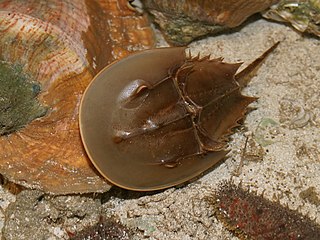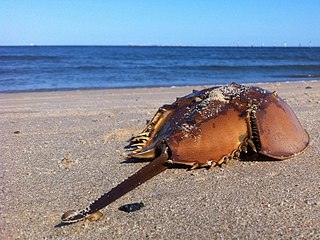
The Atlantic horseshoe crab, also known as the American horseshoe crab, is a species of marine and brackish chelicerate arthropod. Despite their name, horseshoe crabs are more closely related to spiders, ticks, and scorpions than to crabs. This species is found in the Gulf of Mexico and along the Atlantic coast of North America. The main area of annual migration is Delaware Bay along the South Jersey Delaware Bayshore.

Horseshoe crabs are marine and brackish water arthropods of the family Limulidae, suborder Xiphosurida, and order Xiphosura. Their popular name is a misnomer, as they are not true crabs, nor even crustaceans, as crabs are, but a different order of arthropod.

Limulus is a genus of horseshoe crab, with one extant species, the Atlantic horseshoe crab. Many fossil species are known, many of which have since been assigned to other genera.

Limulus amebocyte lysate (LAL) is an aqueous extract of blood cells (amoebocytes) from the Atlantic horseshoe crab Limulus polyphemus. LAL reacts with bacterial endotoxin lipopolysaccharide (LPS), which is a membrane component of gram-negative bacteria. This reaction is the basis of the LAL test, which is widely used for the detection and quantification of bacterial endotoxins.
Eurycheilichthys is a small genus of armored catfishes native to South America.
An amebocyte or amoebocyte is a mobile cell in the body of invertebrates including echinoderms, molluscs, tunicates, sponges and some chelicerates. They move by pseudopodia. Similarly to some of the white blood cells of vertebrates, in many species amebocytes are found in the blood or body fluid and play a role in the defense of the organism against pathogens. Depending on the species, an amebocyte may also digest and distribute food, dispose of wastes, form skeletal fibers, fight infections, and change into other cell types.
Veigaia is a genus of mites in the family Veigaiidae.
Veigaia agilis is a species of mite in the family Veigaiidae.
Veigaia carpillaris is a species of mite in the family Veigaiidae.
Veigaia formosana is a species of mite in the family Veigaiidae.
Veigaia kochi is a species of mite in the family Veigaiidae. It is found in Europe.
Veigaia nemorensis is a species of mite in the family Veigaiidae. It is found in Europe.
Veigaia paradoxa is a species of mite in the family Veigaiidae.
Veigaia pseudouncata is a species of mite in the family Veigaiidae.
Veigaia uncata is a species of mite in the family Veigaiidae.
Limulus clotting factor overbar C is an enzyme. This enzyme catalyses the following chemical reaction
Limulus clotting factor B is an enzyme. This enzyme catalyses the following chemical reaction
Limulus clotting enzyme is an enzyme. This enzyme catalyses the following chemical reaction

Limlu is a village in the Qeshlaq-e Jonubi Rural District, Qeshlaq Dasht District, Bileh Savar County, Ardabil Province, Iran. In the 2006 census, its population was counted as 125, spread across 26 families.

Hao kuih is a special snack originating in Shantou, Guangdong Province, China. It is known for its shape and flavor. First appearing in Chaoyang District in Shantou, Hao kuih is generally not well known beyond the Chaoshan community.





